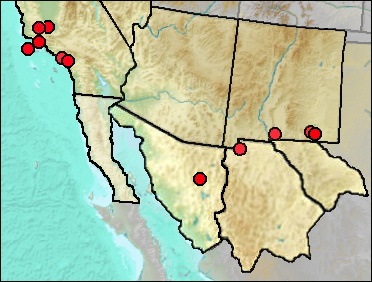Class Aves
Order Falconiformes
Family Falconidae
Caracara cheriway—Crested Caracara // Falco—Falcons
This family has a long history of association with the Accipitridae and Cathartidae as a member of the Falconiformes. Recent advances in taxonomy, however indicate that the Falconidae does not share a close relationship with those families, being more closely related to the Psittaciformes. Thus the Accipitridae and Cathartidae are now placed in an order of their own (Accipitriformes) and the falcons are retained in the Falconiformes.
Falcons are, for the most part, fast-flying predators. The exception is the Crested Caracara, which does a considerable amount of scavenging along with hunting and is more sedentary.

Synonyms. Caracara prelutosa, Polyborus prelutosus, Polyborus plancus prelutosus, Polyborus plancus.
Caracara taxonomy has changed considerably in recent years through splitting. Most of the literature records of fossils from our region were under one of the synonyms noted above.
 Caracaras belong to a different subfamily within the Falconidae from
those we think of as falcons. Rather than using swift flight to bring down prey, they tend to feed
on small ground prey and will readily feed on carrion.
Caracaras belong to a different subfamily within the Falconidae from
those we think of as falcons. Rather than using swift flight to bring down prey, they tend to feed
on small ground prey and will readily feed on carrion.
Fig. 1. Limb bones of Caracara cheriway. From left: left humerus, left femur, right tibiotarsus, left tarsometatarsus. UTEP specimens: Animal Fair: 22-428, 22-711, 22-2035, and Human Corridor: 31-20. Scale in mm.

Fig. 2. Image of a Caracara from a poster by Bob Hines, courtesy of the U.S. Fish and Wildlife Service.
In modern times, southern Arizona is inhabited and Crested Caracaras appear sporadically from Trans-Pecos Texas west to central California. In New Mexico, they have nested near Belen in the Rio Grande Valley near the center of the state (Ligon 1961). They were common in southeastern New Mexico during the late Wisconsin (over 240 bones are catalogued from Dry Cave). It apparently nested within the entrance area of Dry Cave, with both young and adults represented in the deposits.
Sites.
?Late Irvingtonian/Rancholabrean: Emery Borrow Pit (Jefferson 1991a).
Wisconsin: Carpinteria (Guthrie 2009).
Mid Wisconsin: McKittrick (Jefferson 1991a); Térapa (Steadman and Mead 2010).
Mid/Late Wisconsin: Dark Canyon Cave (Howard 1971); Hampton Court (Harris 1993c); Pit N&W Animal Fair (Harris 1993c); San Miguel Island (Guthrie 1998); Shelter Cave (Howard and Miller 1933).
Late Wisconsin: Animal Fair 18-20 ka (Harris 1989); Bison Chamber (Harris 1989); Camel Room (Harris 1993c); Charlies Parlor (Harris 1989); Harris' Pocket (Harris 1989); Human Corridor (Harris 1993c); Maricopa (Jefferson 1991a); Stalag 17 (Harris 1993c); U-Bar Cave 13-14 ka (Harris 1989); U-Bar Cave 14-15 ka (Harris 1989).
Late Wisconsin/Holocene: Balcony Room(Harris 1993c); Conkling Cavern (Howard and Miller 1933).
Literature.
Literature. Guthrie 1998, 2009; Harris 1989, 1993c; Howard 1971; Howard and Miller 1933; Jefferson 1991a; Steadman and Mead 2010.
Last Update: 22 Jun 2014